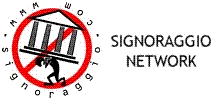La forza della semplicità..
In soldoni: la moneta circolante negli STATI UNITI D'AMERICA NON E' LEGALE.
Seguirà un articolo sulla SCANDALOSA E TACIUTA INCOSTITUZIONALITA' DEL DOLLARO!
Intanto questa paginetta che nella sua semplicità schematica è DISARMANTE!
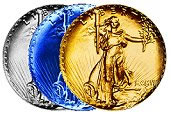
A History Of U.S. Paper Money
(The notes depicted here are for illustrative purposes ONLY)
If you want to know why Gold is anathema to bankers and financial authorities, take a a good close look at these Notes. The history of the move away from Gold in the 20th century is printed right on them.
"Government is the only agency that can take a valuable commodity like paper, slap some ink on it, and make it totally worthless" Ludwig von Mises. For the ultimate illustration of the truth of this statement, we give you the German Reichsmark of the early 1920s
REAL Paper Money
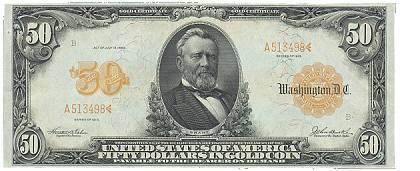
1913: $50 Gold Certificate
The last of the true Gold Certificates - the Federal Reserve was instituted in December 1913. This is a completely honest and upright money. It says so right on the certificate:

What you are looking at here is a money substitute. Any holder of this certificate held title to 2.41896 troy oz of Gold (at $US20.67 per troy oz.) which could be redeemed at any bank or from the U.S. Treasury itself at any time.
Enter The Federal Reserve
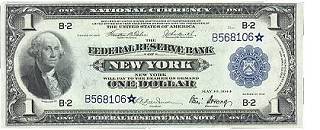
1914: $1 Federal Reserve Bank Note
At the time this was issued, a "note" was well understood to be a promise of payment. Accordingly, this is prominently labelled as a "Federal Reserve Bank Note".
And what is this Note redeemable in? Here's what it says: "Secured By United States Certificates Of Indebtedness Or One-Year Gold Notes, Deposited With The Treasurer Of The United States Of America". The Note was directly redeemable in Treasury debt, but it was not directly redeemable in Gold.
It's Money Because We Say It Is
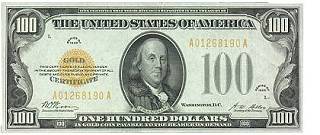
1928: $100 Gold Certificate
The last of the U.S. Gold Certificates. This certificate was discontinued in 1934 - the same year as the U.S. ceased to issue Gold coinage and made it illegal for Americans to own Gold.
While the statement that the certificate is redeemable in Gold coin still appears, there is this ominous addition imprinted on the "Gold Certificate" stamp.
"This Certificate Is A Legal Tender In The Amount Thereof In Payment Of All Debts And Owen Public And Private". "Owen" is an archaic form of the verb "owe", meaning "to be in debt".
Redeemable In What?
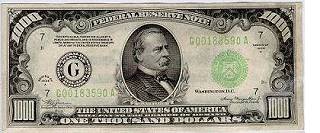
1934: $1000 Federal Reserve Note
As it says right on the note, "The United States Of America Will Pay To The Bearer On Demand One Thousand Dollars". But what is it redeemable in? "Lawful Money".
It says so right on the note: "This Note Is Legal Tender For All Debts Public And Private And Is Redeemable In Lawful Money At The United States Treasury Or At Any Federal Reserve Bank".
In 1934, Gold was no longer "lawful money". In fact, this note was "redeemable" in another note just like it, or 10 "$100s", or 50 "$20s", or 1000 "$1s" - you get the picture.
Remember These?
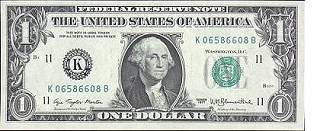
1963: $1 Federal Reserve Note
The U.S. probably printed more of these than any other note in its history. When they first came out, you could buy quite a lot with one. Now, the U.S. $1 Dollar bill is being phased out.
The recognition of what a "note" is is no more. There is no statement about what this note can be redeemed in anywhere on it. Nor does the Fed bother to point out that the note is "lawful money" - just try and spend anything else! The Note simply states: "This Note Is Legal Tender For All Debts Public And Private". That's it.
The New U.S. Paper Money
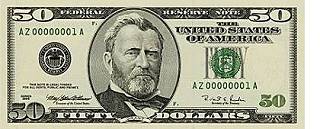
1997: $50 Federal Reserve Note
Here is a specimen of the new "counterfeit proof" U.S. paper currency (the "$100s" came out in 1996). As far as what is written on the note, there is not much to distinguish it from the $1 note above. The only discernible difference is the markedly inferior engraving.
But look at the portrait of Ulysses S. Grant, and then scroll up to the first example on this page. Same man, radically different "money". This is counterfeiting of a much more blatant kind than the mere copying of what is already just a piece of paper.
©2001 The Privateer Market Letter
Back To Top | Next - The Early Gold Wars
Federal Reserve System's
Funny Money Explained
Since 1913 bankers have cheated the American
people with their fraudulent money.
EXCLUSIVE TO THE SPOTLIGHT
By Andrew Arnold
If you tell the average American on the street that the money in his pocket is no good, then you are liable to get a strange look or worse.
After all, those Federal Reserve Notes serve as a medium of exchange for goods, services and in settlement of debt. And Section 411 of Title 31 of the U.S. Code establishes Federal Reserve Notes as obligations of the U.S. government.
But the closer one looks at today's Federal Reserve Notes, and the sinister creation of debt-based money by banks with literally the stroke of a pen (or today, a computer keyboard), the more likely one is to conclude these notes aren't worth the paper upon which they are printed.
For example, today's paper currency has "THIS NOTE IS LEGAL TENDER FOR ALL DEBTS, PUBLIC AND PRIVATE" inscribed on the note. But the note doesn't tell you who, or what is backing the bill.
GOLD STANDARD
From 1878 until 1938, U.S. currency was backed by gold. Before that,
dating back to 1792, Congress followed a bi-metallic standard under which
gold and silver served as dollars.
When Federal Reserve Notes were originally issued in 1914, the gold standard was in practice. The bills were engraved on the reverse with:
THIS NOTE IS RECEIVABLE BY ALL NATIONAL AND MEMBER BANKS AND FEDERAL RESERVE BANKS AND FOR ALL TAXES, CUSTOMS AND OTHER PUBLIC DUES. IT IS REDEEMABLE IN GOLD ON DEMAND AT THE TREASURY DEPARTMENT OF THE UNITED STATES IN THE CITY OF WASHINGTON, DISTRICT OF COLUMBIA OR IN GOLD OR LAWFUL MONEY AT ANY FEDERAL RESERVE BANK.
While many debate the legality of the Federal Reserve, and consequently the lawfulness of these notes, there is no doubt that in 1914 through 1938 the notes were backed by "... gold or lawful money... " (emphasis added).
In 1938, President Franklin Delano Roosevelt issued an executive order to recall all gold and gold certificates.
A year later, Congress passed the Gold Reserve Act which modified the gold standard with a devalued dollar. FDR then issued a proclamation reducing the gold content of the dollar to 59 percent of what was established by the Gold Standard Act of 1900.
A statement on the front of 1950 series Federal Reserve Notes says:
THIS NOTE IS LEGAL TENDER FOR ALL DEBTS, PUBLIC AND PRIVATE, AND IS REDEEMABLE IN LAWFUL MONEY AT THE UNITED STATES TREASURY, OR AT ANY FEDERAL RESERVE BANK
A statement at the bottom of the note says: WILL PAY TO THE BEARER ON DEMAND (followed by the denomination).
These notes were known as credit money - paper money backed by promises by the issuer to pay an equivalent value in the standard monetary metal.
Soon thereafter, the Federal Reserve stopped any pretense of backing the notes with "lawful money." By 1963, the U.S. Treasury and Federal Reserve quit promising to pay anything. The 1963 series Federal Reserve Note declares: THIS NOTE IS LEGAL TENDER FOR ALL DEBTS, PUBLIC AND PRIVATE.
This is what is known as fiat money--paper money that is not redeemable in any other type of money.
The problem with today's fiat money is that it is certificates of indebtedness--promissory notes issued as payment for government bonds which fraudulently require taxpayers to pay annual interest.
Yes, that's right. Politicians require taxpayers to pay interest on their own money. No greater fraud can be imagined. As Thomas Edison once said, "if the government can print bonds, it can print currency."
The nation is, conservatively speaking, nearly $5 trillion in debt, and the Federal Reserve creates "money" out of this debt.
Since Congress handed over the responsibility of making money to the central bank, and the dollar has been taken off the gold standard, nothing backs Federal Reserve Notes.
Around the same time bankers ceased redeeming lawful money, Congress was thoughtful enough to add "In God We Trust" to Federal Reserve Notes. Politicians, if not bankers, want money to have some auspices.
The Treasury still creates coins, but no longer prints U.S. Notes, according to a historian with the Bureau of Printing and Engraving. Some old U.S. Notes are in stock. These, combined with coins, are about the only real money left in circulation (which leads to the conclusion that since coins are issued by the Treasury, and thus carry no debt, a one-dollar coin would be a blessing to the economy.
But it is anathema for bankers for that reason. No wonder newspapers and pundits regularly condemn a one dollar coin.)
The philosophical question for the day is: If you own a promissory note to pay nothing, what will you do when the plutocratic powers that create and control our money supply decree that nothing is exactly what you will get?
19/02/2006 : signet@work : sandro pascucci
: www.signoraggio.com v.0.5
[http://www.signoraggio.com/signoraggio_legaltender_vs_lawfulmoney.html]
